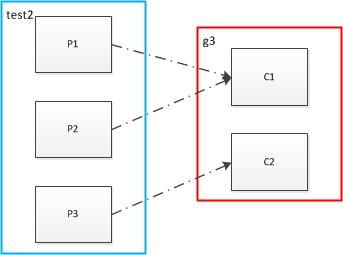kafka中partition和消费者对应关系
1个partition只能被同组的一个consumer消费,同组的consumer则起到均衡效果
消费者多于partition
topic: test 只有一个partition
创建一个topic——test,
bin/kafka-topics.sh --create --zookeeper localhost:2181 --replication-factor 1 --partitions 1 --topic test
在g2组中启动两个consumer,
1. bin/kafka-console-consumer.sh --bootstrap-server localhost:9092 --topic test --from-beginning --consumer.config config/consumer_g2.properties 2. bin/kafka-console-consumer.sh --bootstrap-server localhost:9092 --topic test --from-beginning --consumer.config config/consumer_g2.properties
消费者数量为2大于partition数量1,此时partition和消费者进程对应关系如下:
bin/kafka-consumer-groups.sh --bootstrap-server localhost:9092 --describe --group g2 TOPIC PARTITION CURRENT-OFFSET LOG-END-OFFSET LAG CONSUMER-ID HOST CLIENT-ID test 0 9 9 0 consumer-1-4a2a4aa8-32f4-4904-9c16-1c0bdf7128a2 /127.0.0.1 consumer-1 - - - - - consumer-1-fd7b120f-fd21-4e07-8c23-87b71c1ee8a5 /127.0.0.1 consumer-1
消费者consumer-1-fd7b120f-fd21-4e07-8c23-87b71c1ee8a5无对应的partition。
用图表示为
生产者消费者对应关系1.jpg
如上图,向test发送消息:1,2, 3,4,5,6,7,8,9
只有C1能接收到消息,C2则不能接收到消息,即同一个partition内的消息只能被同一个组中的一个consumer消费。当消费者数量多于partition的数量时,多余的消费者空闲。
也就是说如果只有一个partition你在同一组启动多少个consumer都没用,partition的数量决定了此topic在同一组中被可被均衡的程度,例如partition=4,则可在同一组中被最多4个consumer均衡消费。
消费者少于和等于partition
topic:test2包含3个partition
bin/kafka-topics.sh --create --zookeeper localhost:2181 --replication-factor 1 --partitions 3 --topic test2
开始时,在g3组中启动2个consumer,
1.bin/kafka-console-consumer.sh --bootstrap-server localhost:9092 --topic test2 --from-beginning --consumer.config config/consumer_g3.properties 2.bin/kafka-console-consumer.sh --bootstrap-server localhost:9092 --topic test2 --from-beginning --consumer.config config/consumer_g3.properties
则对应关系如下:
TOPIC PARTITION CURRENT-OFFSET LOG-END-OFFSET LAG CONSUMER-ID HOST CLIENT-ID test2 0 8 8 0 consumer-1-8b872ef7-a2f0-4bd3-b2a8-7b26e4d8ab2c /127.0.0.1 consumer-1 test2 1 7 7 0 consumer-1-8b872ef7-a2f0-4bd3-b2a8-7b26e4d8ab2c /127.0.0.1 consumer-1 test2 2 8 8 0 consumer-1-f362847d-1094-4895-ad8b-1e1f1c88936c /127.0.0.1 consumer-1
其中,consumer-1-8b872ef7-a2f0-4bd3-b2a8-7b26e4d8ab2c对应了2个partition
用图表示为:
生产者消费者对应关系2.jpg
消费者数量2小于partition的数量3,此时,向test2发送消息1,2,3,4,5,6,7,8,9
C1接收到1,3,4,6,7,9
C2接收到2,5,8
此时P1、P2对对应C1,即多个partition对应一个消费者,C1接收到消息量是C2的两倍
然后,在g3组中再启动一个消费者,使得消费者数量为3等于topic2中partition的数量
3.bin/kafka-console-consumer.sh --bootstrap-server localhost:9092 --topic test2 --from-beginning --consumer.config config/consumer_g3.properties
对应关系如下:
TOPIC PARTITION CURRENT-OFFSET LOG-END-OFFSET LAG CONSUMER-ID HOST CLIENT-ID test2 0 8 8 0 consumer-1-8b872ef7-a2f0-4bd3-b2a8-7b26e4d8ab2c /127.0.0.1 consumer-1 test2 1 7 7 0 consumer-1-ab472ed5-de11-4e56-863a-67bf3a3cc36a /127.0.0.1 consumer-1 test2 2 8 8 0 consumer-1-f362847d-1094-4895-ad8b-1e1f1c88936c /127.0.0.1 consumer-1
此时,partition和消费者是一对一关系,向test2发送消息1,2,3,4,5,6,7,8,9
C1接收到了:2,5,8
C2接收到了:3,6,9
C3接收到了:1,4,7
C1,C2,C3均分了test2的所有消息,即消息在同一个组之间的消费者之间均分了!
多个消费者组
启动g4组,仅包含一个消费者C1,消费topic2的消息,此时消费端有两个消费者组
bin/kafka-console-consumer.sh --bootstrap-server localhost:9092 --topic test2 --from-beginning --consumer.config config/consumer_g4.properties --delete-consumer-offsets
g4组的C1的对应了test2的所有partition:
bin/kafka-consumer-groups.sh --bootstrap-server localhost:9092 --describe --group g4 TOPIC PARTITION CURRENT-OFFSET LOG-END-OFFSET LAG CONSUMER-ID HOST CLIENT-ID test2 0 36 36 0 consumer-1-befc9234-260d-4ad3-b283-b67a2bf446ca /127.0.0.1 consumer-1 test2 1 35 35 0 consumer-1-befc9234-260d-4ad3-b283-b67a2bf446ca /127.0.0.1 consumer-1 test2 2 36 36 0 consumer-1-befc9234-260d-4ad3-b283-b67a2bf446ca /127.0.0.1 consumer-1
用图表示为
生产者消费者对应关系3.jpg
如上图,向test2发送消息1,2,3,4,5,6,7,8,9
那么g3组各个消费者及g4组的消费者接收到的消息是怎样地呢?欢迎思考!!
答案:
消息被g3组的消费者均分,g4组的消费者在接收到了所有的消息。
g3组:
C1接收到了:2,5,8
C2接收到了:3,6,9
C3接收到了:1,4,7
g4组:
C1接收到了:1,2,3,4,5,6,7,8,9
启动多个组,则会使同一个消息被消费多次
Consumer Rebalance的算法如下:
- 将目标Topic下的所有Partirtion排序,存于PT
- 对某Consumer Group下所有Consumer排序,存于CG,第ii个Consumer记为Ci
- N=size(PT)/size(CG),向上取整
- 解除Ci对原来分配的Partition的消费权(i从0开始)
- 将第i∗N到(i+1)∗N−1个Partition分配给Ci


